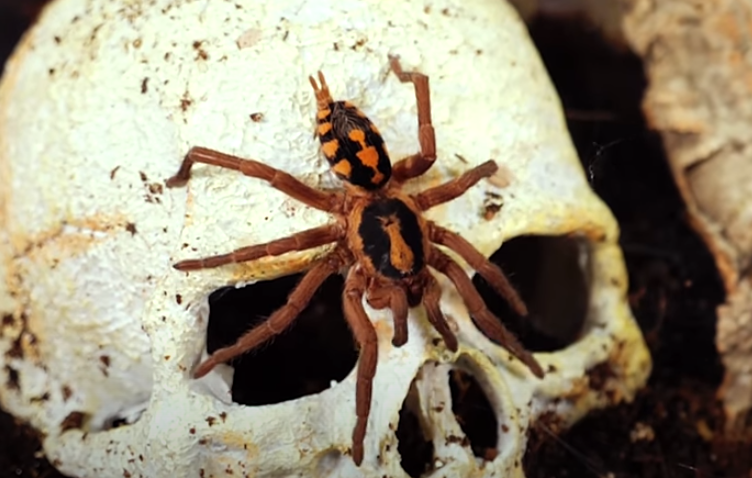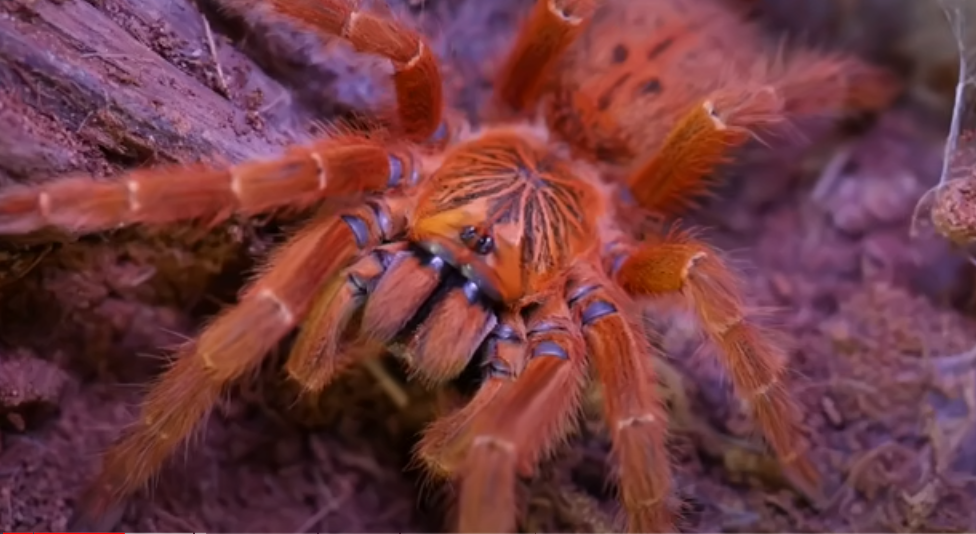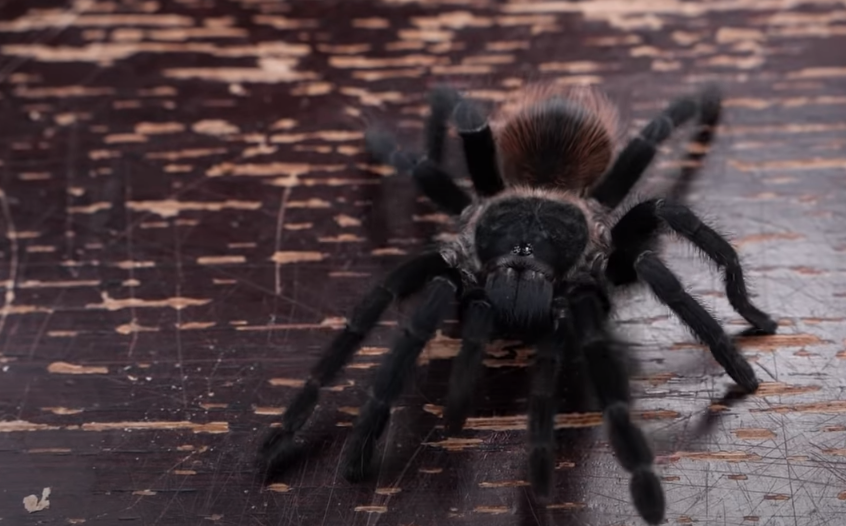For many, the thought of tarantulas with wings may conjure up images of mythical creatures or creatures from horror films. But are these winged tarantulas real or simply a myth? In this section, we will explore the truth behind this fascinating topic and delve into the science and research surrounding it.
Table of Contents
Toggle- The idea of tarantulas possessing wings is a popular belief but has yet to be proven.
- Scientific research and studies are ongoing to determine the truth behind the existence of winged tarantulas.
- Despite the lack of evidence for winged tarantulas, they remain a fascinating topic of discussion and intrigue for many.
Winged Tarantulas – A Mythical Creature?
For years, the idea of winged tarantulas has captured the imagination of people all over the world. But are tarantulas with wings just a figment of our imagination or do they really exist?
The notion of tarantulas that can fly is indeed a popular myth. While it is true that some species of tarantulas have developed impressive aerial abilities, they do not possess wings. In fact, no known species of tarantula has ever been found to have wings, and there is no scientific evidence to support the idea of flying tarantulas.
So where did the myth of winged tarantulas come from? The belief likely stems from the fact that some species of tarantulas have specialized hairs on their bodies that help them to glide through the air. These hairs, called “urticating hairs,” can be released by the tarantula with wings as a form of defense mechanism against predators. When these hairs are released, they can create a fine mist that irritates the predator’s eyes and skin, allowing the tarantula to escape.
While these urticating hairs can give the illusion of wings, they are not the same as actual wings. Furthermore, not all tarantulas possess these specialized hairs, and even among those that do, they are used primarily as a defense mechanism rather than for flight.
In short, while the idea of flying tarantulas or tarantula with wings is an intriguing one, it remains nothing more than a myth. Tarantulas are impressive creatures in their own right, possessing a range of unique adaptations and behaviors that have helped them to thrive in a variety of habitats.
Winged Spiders in Nature
While the idea of winged tarantulas may seem like a fascinating myth, the reality is that there are no known species of tarantulas with wings. However, there are certain species of spiders that have developed wings to aid in their survival and reproduction.
One such example is the family of arachnids known as the Chelicerata, which includes spiders, scorpions, and ticks. Some members of this group, such as the orb-weaving spiders, have evolved the ability to glide through the air using their silk threads, known as ballooning.

In addition to ballooning, there are some spider species that have developed wings as a means of transport or defense. For instance, the tropical species of spider known as the Selenops may use its wings to glide from tree to tree, while the golden orb-weaver spider has been observed using its wings to make sudden movements to avoid predators.
It’s important to note, however, that these winged spiders are not the same as tarantulas and belong to different families of arachnids. While there is still much to learn about the evolution and behavior of these winged arachnids, they provide an interesting glimpse into the diversity of spider species that exist in nature.
The Aerial Capabilities of Tarantulas
Tarantulas are not typically associated with flying or gliding, but recent research suggests that these creepy crawlies may possess aerial capabilities that are unique among arachnids. While tarantulas cannot fly in the traditional sense, they can glide through the air for short distances, using a variety of physical adaptations that allow them to navigate through the environment with surprising grace.

One key adaptation that tarantulas possess is specialized hairs on their bodies that create an aerodynamic effect when exposed to air. These hairs help the spider to control its movement through the air, altering its trajectory and slowing its descent as it falls from tree branches or other high points. Tarantulas also have unique appendages on their abdomens called spinnerets, which can produce silk that the spider uses as a sort of safety line to anchor itself in place or change direction mid-flight.
Despite these adaptations, gliding through the air is not a typical mode of transportation for tarantulas. Instead, they typically only glide when attempting to escape from predators or when searching for food or mates in hard-to-reach areas. These glides are usually short and relatively low to the ground, with the spider using its powerful legs to launch itself into the air and control its descent back to the earth.
While tarantulas may not be the first creatures that come to mind when we think of aerial abilities, their unique adaptations and surprising agility make them fascinating examples of the incredible diversity of life on our planet.
The Science Behind Flying Tarantulas
While the idea of tarantulas with wings may seem far-fetched, there has been scientific research and studies conducted to understand the phenomenon of “flying” tarantulas. However, the term “flying” is a misnomer, as tarantulas are not capable of true flight like birds or insects.
Instead, tarantulas possess unique adaptations that allow them to “glide” or “parachute” through the air. This is possible due to specialized hairs on their bodies, known as setae, which help create air resistance and slow their descent. In addition, tarantulas have flaps of skin on their abdomens called “spinnerets,” which can produce silk that they use to control their descent and steer themselves towards a particular location.
Research has also shown that certain species of tarantulas may be more adept at gliding than others. For example, the Mexican red-kneed tarantula (Brachypelma smithi) has been observed gliding distances of up to 50 feet in the wild.
Despite these findings, there is no evidence to suggest that tarantulas possess actual wings. The so-called tarantula with wings or “winged tarantulas” that are sometimes depicted in folklore and popular culture are purely fictional.

“Tarantulas possess unique adaptations that allow them to ‘glide’ or ‘parachute’ through the air.”
Furthermore, it is important to note that not all tarantula species are capable of gliding. While some species have developed the necessary adaptations to navigate through the air, others have not. It is also worth mentioning that the ability to glide may not necessarily confer an evolutionary advantage for tarantulas, and may simply be a rare and unique trait that certain species possess.
The Evolutionary Significance of Wings in Tarantulas
Wings are one of the most fascinating evolutionary adaptations that animals have developed, allowing them to explore new environments and access new food sources. When it comes to tarantulas, however, the question of winged arachnids or tarantula with wings is shrouded in mystery and controversy.
Despite numerous reports of tarantulas with wings, the scientific community remains divided on the existence of such creatures. Some experts argue that the idea of winged tarantulas is purely mythological, with no evidence to support the notion.
Others, however, believe that there may be certain species of tarantulas that have developed wings or aerial capabilities over time. These adaptations may have provided advantages in terms of hunting, escaping predators, or finding suitable mates.
One theory suggests that tarantulas may use their wings to glide through the air, making it easier for them to navigate through their natural habitats. Some species, such as the Mexican Redknee tarantula, have been observed using their hind legs to create a “parachute” effect, allowing them to glide for short distances.

However, despite these observations, there is still much debate and uncertainty surrounding the topic of flying tarantulas or tarantula with wings. Some argue that the aerial capabilities of tarantulas are simply a result of their strong leg muscles and ability to jump great distances, rather than any specialized adaptations for flight.
Ultimately, the question of winged tarantulas remains one of the great mysteries of the arachnid world. While scientific research and studies continue to shed light on the topic, much remains to be discovered and explored.
Whether or not tarantulas possess wings, these incredible creatures continue to inspire awe and fascination among scientists and enthusiasts alike. Their impressive adaptations and unique behaviors make them an integral part of the natural world, and a true wonder to behold.
Debunking the Myth – Flying Tarantulas Explained
The idea of tarantulas with wings or the ability to fly has captured the imaginations of many people, but the truth is that flying tarantulas or tarantula with wings are a myth. Despite popular belief, there is no scientific evidence to support the existence of tarantulas with wings.
Experts in the field of arachnology have studied tarantulas and other spiders extensively and have not found any conclusive evidence to suggest that tarantulas can fly. While some spider species have developed wings, no known tarantula species possesses this characteristic.
So, why does the myth of flying tarantulas and tarantula with wings persist? One possible explanation is that the large size and intimidating appearance of tarantulas may lead people to imagine them as even more extraordinary creatures than they already are.
Another reason could be the fact that tarantulas are known to have impressive aerial capabilities. Some species are known to glide short distances by using specialized hairs on their legs as airfoils. This may have contributed to the misconception that tarantulas are capable of true flight.
Ultimately, the truth is clear – flying tarantulas are not real. While tarantulas are fascinating creatures with unique adaptations, the ability to fly or possess wings is not one of them. Tarantula with wings is still a question.

“There is no scientific evidence to support the existence of tarantulas with wings.”
Tarantulas and their Impressive Adaptations
Tarantulas are fascinating creatures that have developed a variety of incredible adaptations to survive in their natural habitats. While they may not possess wings, they have other remarkable characteristics that make them exceptional arachnids.
One of the most impressive adaptations of tarantulas is their ability to defend themselves from predators using their venomous bites. They have large fangs that can rapidly inject venom into their prey, instantly incapacitating them. Additionally, tarantulas have specialized hairs on their bodies that they can flick towards predators, causing irritation and discomfort.
Tarantulas also possess remarkable physical strength. They can lift objects up to ten times their own weight and are powerful enough to subdue prey much larger than themselves. This strength comes in handy when building their burrows, which can be up to several feet deep and feature elaborate tunnels and chambers.
Another impressive adaptation of tarantulas is their ability to regenerate lost limbs. If a tarantula loses a leg or other appendage, it can regrow it over time. This is a crucial survival mechanism that allows tarantulas to continue hunting and moving even after being injured.
In addition to these adaptations, tarantulas have unique behaviors that contribute to their success as a species. They are nocturnal creatures that are most active at night, hunting for prey and mating with potential partners. They also use their specialized hairs to sense their surroundings and communicate with other tarantulas.
Overall, tarantulas may not have wings or the ability to fly, but they are still incredibly fascinating creatures that have developed a range of remarkable adaptations to survive in their environments. Their venomous bites, physical strength, ability to regenerate lost limbs, and unique behaviors all contribute to their success as apex predators in the world of arachnids.

Adaptation Facts
Tarantulas are fascinating creatures that have captured the curiosity of humans for centuries. With over 900 known species, these spiders are found in almost every part of the world, from deserts to rainforests. While many people picture tarantulas as creepy and dangerous, these arachnids are actually quite fascinating.
One of the most intriguing aspects of tarantulas is their incredible adaptations. Tarantulas are known for their ability to hunt and capture prey with precision and speed. Some species, such as the Goliath birdeater, have even been known to eat birds and small mammals.
But it’s not just their hunting abilities that make tarantulas fascinating. Some species of tarantulas have developed wings, allowing them to glide through the air in search of food or to escape predators. These winged tarantulas are often mistaken for flying spiders, but they are a unique species in their own right.
Winged tarantulas are not the only arachnids with aerial capabilities, however. There are also other species of winged spiders, such as the orb-weaving spider and the spiny orb-weaver, that have developed wings to assist them in gliding through the air.
While it is still debated whether tarantulas truly have wings or not, there is no denying the impressive adaptations these spiders possess. From their hairy bodies that provide protection and camouflage to their venomous bites and silk-producing abilities, tarantulas are a true wonder of nature.

If you’re interested in learning more about tarantulas, there are many resources available online and in books. You can also visit a local zoo or spider exhibit to observe these fascinating creatures up close and personal.
Whether you’re fascinated by winged spiders, flying tarantulas, tarantula with wings or simply appreciate the incredible adaptations of these arachnids, the world of tarantulas is sure to captivate and inspire.
Conclusion
In conclusion, the existence of tarantulas with wings remains a popular belief but lacks scientific evidence. While it is fascinating to imagine these hairy spiders gliding through the air, the truth is that tarantulas do not possess wings.
However, this does not diminish the impressive aerial capabilities that certain species of tarantulas do possess. These spiders have evolved unique adaptations that allow them to navigate through the air with remarkable precision and efficiency, such as specialized hairs and appendages.
Studying tarantulas and their adaptations offers valuable insights into the natural world and the evolution of arachnids. By continuing to explore and study these fascinating creatures, we can uncover new discoveries and gain a greater appreciation for the diversity of life on our planet.
FAQ
Are tarantulas with wings a real thing?
No, tarantulas with wings are not a real thing. This is a myth and not supported by scientific evidence.
Do any spiders have wings?
No, spiders do not have wings. Spiders belong to the arachnid family, and their body structure does not include wings.
Can tarantulas fly?
Tarantulas cannot fly. They are ground-dwelling arachnids that rely on walking and crawling to move around.
How do flying tarantula myths originate?
The myth of flying tarantulas may have originated from misinterpretations or exaggerations of the spiders’ natural behaviors, such as jumping or gliding short distances.
Is there any scientific evidence of flying tarantulas?
No, there is no scientific evidence to support the existence of tarantulas with wings or the ability to fly.
What adaptations do tarantulas have for aerial movement?
Tarantulas have specialized hairs called setae that help them sense air currents and vibrations. These hairs aid in their mobility but do not give them the ability to soar through the air.
Are there any spiders that can fly?
Yes, some species of spiders, such as the family Salticidae (jumping spiders), can perform short jumps or glides using silk strands. However, this is different from true flight.
Why are tarantulas so fascinating?
Tarantulas are intriguing creatures due to their unique appearance, behaviors, and adaptations. They play important roles in ecosystems and are fascinating subjects for scientific study.
What are some interesting facts about tarantulas?
Tarantulas can live for several decades, molt to grow, and have venomous fangs for subduing prey. They are found in various habitats worldwide and exhibit diverse behaviors.
Where can I learn more about tarantulas?
There are numerous resources available, including books, online articles, and wildlife organizations, that provide in-depth information about tarantulas. Conducting specific research will help you uncover more about these incredible arachnids.






